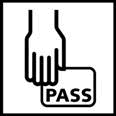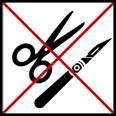 Two – not one but TWO – works of art fell off the wall during the “Los Angeles 1955-85” Exhibition this Summer at the Centre Pompidou. On two separate occasions – yes, TWO. Don’t they know how to hammer a nail?
Two – not one but TWO – works of art fell off the wall during the “Los Angeles 1955-85” Exhibition this Summer at the Centre Pompidou. On two separate occasions – yes, TWO. Don’t they know how to hammer a nail?Well, apparently, an internal investigation was required in order to answer this question. Although I’ve never witnessed such an investigation, I would imagine that it entails Pompidou president Bruno Racine pointing at curators and art handlers and screaming “YOU, you must be the one to take the blame!” until somebody breaks down and cries.
In the first instance, it would appear that Bruno must have seen quite a few of his good people shed a tear before he obtained a full report. Indeed, the art handler blamed the restorer who blamed the person who then hung the piece who in turn blamed the restorer. Peter Alexander’s untitled 1971 piece is a vertical bar of resin nearly eight feet long. Some people would find it surprising that a big bar of resin should be hung on the Pompidou’s walls but that’s the subject of another discussion. “YOU, you must pay attention!” as Bruno would say.
So Peter Alexander’s untitled 1971 piece was about to be installed when art handlers noticed that a small metal ring inserted into the hanging hole was loose! Oh my! A restorer was immediately called in to glue the metal ring back on. Yes, some people are on-call for their knowledge of glue. She then instructed the people who were to hang the piece (I wonder if they’re called the hangers) to let the glue set for 24 hours. Well it would appear that some of her wisdom was “misinterpreted” because the work was hung that same day. It fell from the wall that very same night.
Now, of course, the Pompidou takes full responsibility, blaming the restorer who was an outside contractor. Bruno said, disapprovingly, that “It is clear the instructions should have been made in a written form.” Yes, had it been done by a glue specialist of the Pompidou, he would have known to make a little sign specifying “YOU, you must LET GLUE DRY FOR A FULL DAY!”
As for the mysterious incident of the falling Untitled Wall Relief of 1967 by Craig Kauffman, Bruno had to admit that his investigation was inconclusive. The convex bubble of acrylic-painted Plexiglas, whose upper edge slotted into a wall-mounted molding, just fell and broke after 130 days of apparently stable display. Then again, Bruno suspects that the hanging might have been flawed. You see, it was fabricated by the lender and its installation was overseen by an objects conservator that was not employed by the Pompidou. What’s more, according to Bruno, if the hanging was flawed, a visitor may have touched the work and dislodged it from its mount leading to its fall later.
Now that’s what I call taking full responsibility…









